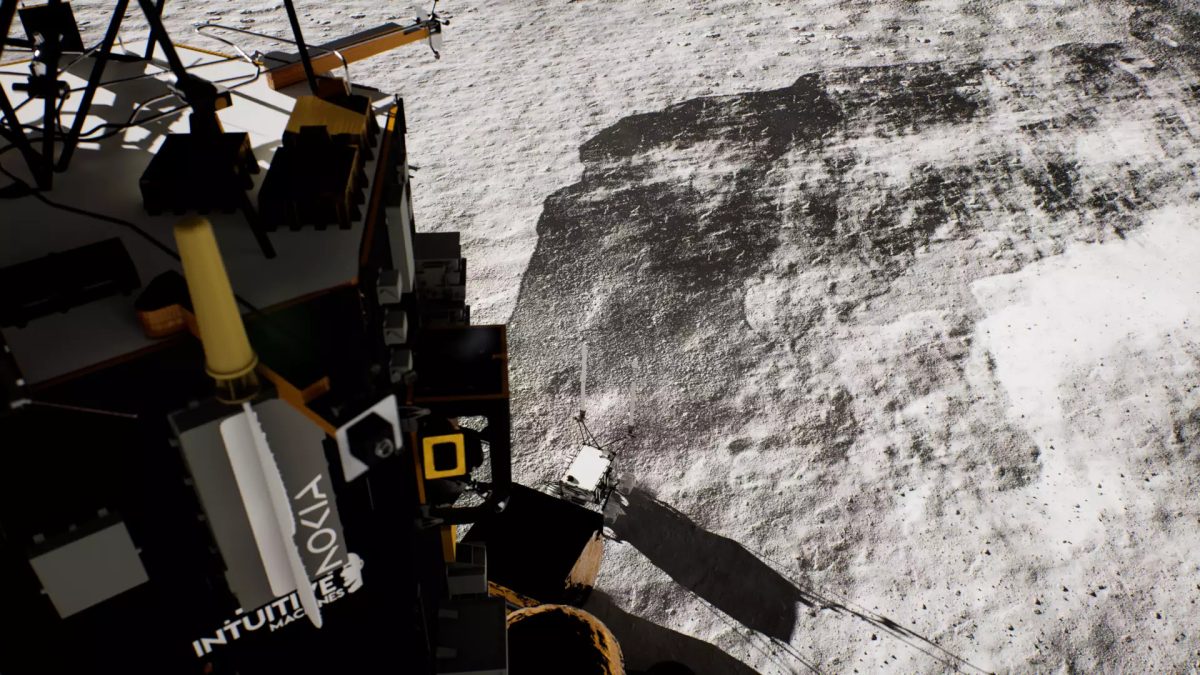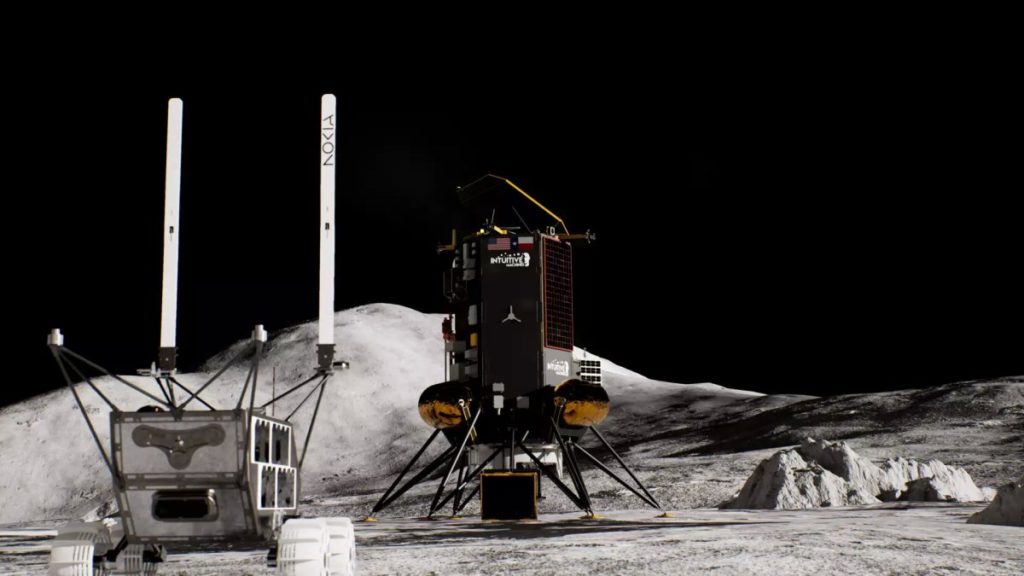Nokia Bell Labs is deploying the first cellular network on the Moon to demonstrate that cellular technologies can provide the critical communications needs for future lunar or Martian missions.
NASA has selected Nokia to participate in its Tipping Point initiative, which seeks industry-developed space technologies that can foster the development of commercial space capabilities and benefit future NASA missions. To that end, Nokia has partnered with Intuitive Machines and Lunar Outpost for the uncrewed lunar mission called IM-2, which will land at the Moon’s south pole. IM-2 is currently scheduled to launch within a three-month window beginning in November of 2023, but that window may shift depending on launch scheduling.
For this mission, Nokia Bell Labs has developed a low-power, compact and space-hardened version of its 4G/LTE microcell. The network is specifically designed to survive the journey to the Moon and operate under the extreme temperature, radiation and environmental conditions of the lunar surface.
The lunar 4G/LTE system will have two primary components. The first is the base station unit, which will be integrated directly into Intuitive Machines’ spacecraft, the Nova-C lander, and act as the cell-site for the Moon network. The second component will be the radio equipment installed on two lunar vehicles: Lunar Outpost’s Mobile Autonomous Prospecting Platform (MAPP) rover and Intuitive Machines’ Micro-Nova hopper. Together these radio components will form a network that will allow the vehicles and lander to communicate with one another. A powerful direct-to-Earth radio connection from the lander will provide a link home, over which mission controllers will receive data and images and remotely operate the vehicles over the cellular network.
Thierry Klein, President of Bell Labs Solutions Research at Nokia, said: “Like shelter, food and life support, communications will be a crucial component of any future lunar or Mars mission. Instead of ‘reinventing the wheel’ by creating a proprietary network in space, we are taking advantage of the same state-of-the-art technologies that connect billions of smartphones on Earth.”
Klein continued: “Humanity has always been fascinated by space, and that interest has only intensified in the 21st century. We are sending more humans and more machines into space to explore, study and even pursue new business ventures. Wherever these humans and machines go in the solar system, they will need communications. Nokia is prepared to make that journey with them.”
“We are sending more humans and more machines into space to explore, study and even pursue new business ventures. Wherever these humans and machines go in the solar system, they will need communications. Nokia is prepared to make that journey with them,” Thierry Klein, President of Bell Labs Solutions Research at Nokia added.
Nokia wants to prove that cellular technologies can provide the reliable, high-capacity and efficient connectivity needed for future crewed and uncrewed missions to the Moon and other planets.
For any sustained human presence on the Moon and on Mars in the future, connectivity and communications are critical. Astronauts will need the same advanced capabilities in space that we have on Earth to support their missions and live their lives. They will need access to voice, video and data communications capabilities as well as telemetry and biometric data. To perform their mission tasks, they will need tap into vast sensor grids, deploy scientific payloads and experiments, and remotely operate robots and other machinery. All these scenarios and applications will require robust network connectivity.
Nokia Bell Labs wants to meet the critical communications needs of space exploration for near-term and long-term missions. We feel the best way to do this isn’t by inventing an entirely new communications platform for planetary exploration. Rather, we should take advantage of the same technologies that connect billions of phones and devices here on Earth.
The IM-2 mission will launch from NASA’s Kennedy Space Center at Cape Canaveral, Fla. A SpaceX Falcon 9 rocket will ferry the Nova-C lander into space on a direct trajectory to the Moon. From there, the lander will initiate its first sequence of engine burns, which will keep it and the Nokia network on course for the long journey to the Moon.
After approximately five days of traveling through space, the Nova-C lander will enter the Moon’s orbit for one Earth-day. After circling the Moon multiple times, the lander will fire its engines once again to make a controlled descent to the lunar surface. The targeted landing zone is Shackleton Connecting Ridge at the Moon’s south pole.
IM-2 has multiple mission goals. To name a few, IM-2 will deploy a York Space Systems communications satellite into lunar orbit; it will excavate the lunar regolith with NASA’s PRIME-1 drill; it will search for evidence of lunar ice; and it will deploy the first exploration vehicles on the Moon’s south pole. Nokia’s 4G/LTE network will be a key element of several of these mission tasks, providing the underlying connectivity between the Nova-C lander and two mission vehicles.
Once on the lunar surface, the Nova-C lander will automatically deploy our network. The lander will lower a protective enclosure containing the Lunar Outpost MAPP rover to the ground. After the rover trundles onto the lunar surface, it will extend its antennas and establish a connection to the base station.
The MAPP rover will then begin a multi-day journey exploring the Shackleton Connecting Ridge. The rover will autonomously map the lunar surface while collecting stereo imagery and thermal data along the way. Most significantly, MAPP will collect samples of lunar regolith in a special bin mounted on the rover’s wheels. Images of this material, the first ever collected from the Moon’s south pole, will be sent back to NASA for analysis.
The trove of data collected on IM-2 will give us a wealth of knowledge about a key area of the Moon, helping pave the way for future crewed Artemis missions. Discovering water at the Shackleton Connecting Ridge would set the stage for a permanent habitat at the Moon’s south pole, as water ice could be converted to breathable oxygen and even used to create fuel for an eventual journey to Mars.
Meanwhile, the data that Nokia Bell Labs collects from the IM-2 mission will be critical for advancing communications technologies in space exploration. Not only could Nokia design and build networks and devices that are optimized for future lunar and Martian missions, but the knowledge we glean would lead to further improvements to networks deployed in harsh environments right here on Earth.
“Instead of ‘reinventing the wheel’ by creating a proprietary network in space, we are taking advantage of the same state-of-the-art technologies that connect billions of smartphones on Earth.” Thierry Klein, President of Bell Labs Solutions Research at Nokia concluded.
Source: Spark Communications

